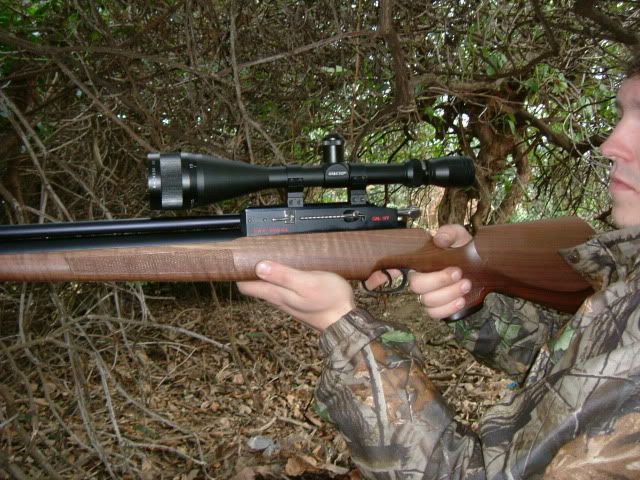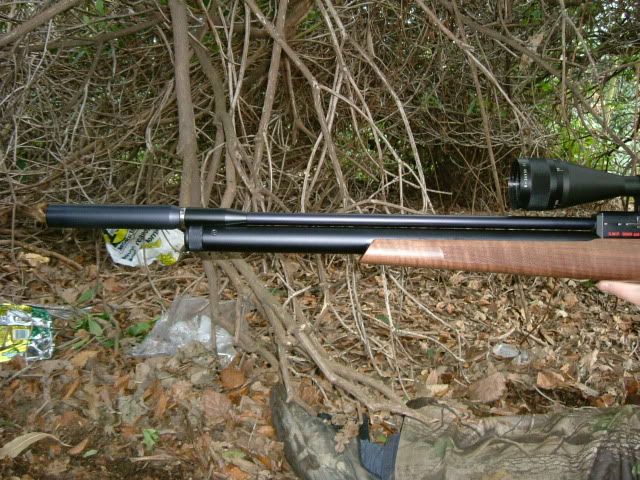Well shorter barrels tend to have higher twist rates in firearms. With air rifles there are various twist rates used, but i think it goes on who manufactured them.
Have a look here.
http://www.airgun.co.uk/Airgun_Accurracy.html
Twist Rate
What enables this high tech boat tail bullet to be aerodynamic, and very accurate, is the rifling in the barrel, that it is designed to be shot from. These rifles usually have a fast twist rate; in fact, they have a very fast twist rate. This causes the bullet to rotate very, very fast. Without this fast rate of rotation, our high tech bullet would probably flip end over end, and it would, of course, not be worth much in the accuracy department.
Rotating our pellets, through the use of rifled barrels, helps give them stability; so, they do not flip end over end.
One of the questions that we need to address, is how fast do our pellet need to spin? Airgun barrels come in twist rates from, as slow as, 1 turn in 20 inches to 1 turn in 12 inches. How do we decide which is best? And does it really matter?
Without going into a bunch of theory about which twist rate is best; lets look at what works, and why it works. The object of the rifling is to rotate the pellet, and what we are really interested in, is the pellets rotation rate. To understand rotation rate, we need to look at some math. Rotation Rate = (12 / Twist Rate) * Muzzle Velocity, in feet per-second. The number 12 comes from 1 turn in a foot, or 12 inches; since we are using feet per-second. This gives our 150 grain 30 caliber rifle bullet a rotation rate of 174,000 revolutions per-minute, or 2900 revolutions per-second. Now, that’s what I call spinning!
We don't have to do this math to realize that the faster we shoot our pellet, the faster it will be rotating. While, I am going against modern ballistic theory; I will say that this theory does not have to deal with shooting the same pellet/bullet out of the same barrel at 500 FPS, and 1000 FPS.
When you combine that with air gun barrel twist rates ranging from 1 turn in 20,1 turn in 18, 1 turn in 16, 1 turn in 14, and 1 turn in 12; somebody has got to be wrong somewhere!
However, since the actual rate of rotation is controlled by both velocity and twist rate; these twist rates are not really that far off the mark. However, airgun pellets have bigger problems built into their design.
And a bit more
To be real blunt, I think that a twist rate of 1 turn in 18 inches is just great for ten meter guns; but, for longer ranges, the twist rate should be at least 1 turn in 16 inches. If you only want to punch nice round holes in paper at ten meters, static and/or dynamic unbalance becomes the thing to worry about;
but, as our pellet reaches further and further out. Faster twist rates mean greater pellet stability; which means greater shot to shot consistency, or accuracy. It seems that some barrel maker's think that we all shoot at ten meters, and no further..... Oddly enough one of the worlds most popular Ten Meter Match gun makers, actually use a twist rate of 1 turn in 14 inches; with out any ill effects. Go Figure! I do prefer a twist rate of 1 turn in 14 inches, for the longer pellets, like the 10.5 grain Crosman Premier, and the H&N Barracuda
Faster Twist Rates
According to Rinker's book, "
Mathematics can show that both static and dynamic unbalance can be improved by a slow twist. On the other hand, the stability factor is improved by a faster twist." What Rinker appears to be saying is that while the slower twist reduces the unbalance; a faster twist increases pellet stability. Any increase in the stability factor increases consistency, which is accuracy. In other words as long as we don't go nuts with our twist rates; accuracy will be improved with a higher rate of twist. Or to be more precise a faster rate of rotation. We can increase the rotation rate by increasing our muzzle velocity; however, in the UK this can be breaking the law.
What are you pointing out? Do you think that your air rifle barrel would have a different twist rate if it was shorter?




